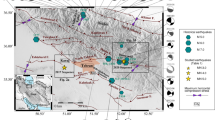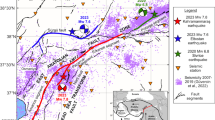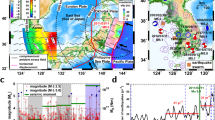Abstract
Decelerating generation of preshocks in a narrow (seismogenic) region and accelerating generation of other preshocks in a broader (critical) region, called decelerating–accelerating seismic strain (D-AS) model has been proposed as appropriate for intermediate-term earthquake prediction. An attempt is made in the present work to identify such seismic strain patterns and estimate the corresponding probably ensuing large mainshocks (M ≥ 7.0) in south Japan (30–38° N, 130–138° E). Two such patterns have been identified and the origin time, magnitude, and epicenter coordinates for each of the two corresponding probably ensuing mainshocks have been estimated. Model uncertainties of predicted quantities are also given to allow an objective forward testing of the efficiency of the model for intermediate-term earthquake prediction.
Similar content being viewed by others
References
Allègre CJ, Le Mouël JL (1994) Introduction of scaling techniques in brittle failure of rocks. Phys Earth Planet Inter 87:85–93. doi:10.1016/0031-9201(94)90023-X
Andersen JV, Sornette D, Leung KT (1997) Tri-critical behavior in rupture induced by disorder. Phys Rev Lett 78:2140–2143. doi:10.1103/PhysRevLett.78.2140
Ben-Zion Y, Lyakhovsky V (2002) Accelerated seismic release and related aspects of seismicity patterns on earthquake faults. Pure Appl Geophys 159:2385–2412. doi:10.1007/s00024-002-8740-9
Ben-Zion Y, Dahmen K, Lyakhovsky V, Ertas D, Agnon A (1999) Self-driven mode switching of earthquake activity on a fault system. Earth Planet Sci Lett 172:11–21. doi:10.1016/S0012-821X(99)00187-9
Ben-Zion Y, Eneva M, Liu Y (2003) Large earthquake cycles and intermittent criticality on heterogeneous faults due to evolving stress and seismicity. J Geophys Res 108:2307. doi:10.1029/2002JB002121
Bowman DD, King GC (2001) Accelerating seismicity and stress accumulation before large earthquakes. Geophys Res Lett 28:4039–4042. doi:10.1029/2001GL013022
Bowman DD, Sammis CG (2004) Intermittent criticality and the Gutenberg–Richter distribution. Pure Appl Geophys 161:1945–1956. doi:10.1007/s00024-004-2541-z
Bowman DD, Quillon G, Sammis CG, Sornette A, Sornette D (1998) An observational test of the critical earthquake concept. J Geophys Res 103:24359–24372. doi:10.1029/98JB00792
Brehm DJ, Braile LW (1999) Intermediate-term earthquake prediction using the modified time-to-failure method in southern California. Bull Seismol Soc Am 89:275–293
Bufe CG, Varnes DJ (1993) Predictive modeling of seismic cycle of the Great San Francisco Bay Region. J Geophys Res 98:9871–9883. doi:10.1029/93JB00357
Du W, Sykes LR (2001) Changes in frequency of moderate-size earthquakes and Coulomb failure stress before and after the Landers, California, earthquake of 1992. Bull Seismol Soc Am 91:725–738. doi:10.1785/0120000224
Enescu B, Ito K (2001) Some premonitory phenomena of the 1995 Hyogo-Ken Nanbu (Kobe) earthquake: seismicity, b-value and fractal dimension. Tectonophysics 338:297–314. doi:10.1016/S0040-1951(01)00085-3
Evison FF (2001) Long-range synoptic earthquake forecasting: an aim for the millennium. Tectonophysics 333:207–215. doi:10.1016/S0040-1951(01)00076-2
Evison FF, Rhoades DA (1997) The precursory earthquake swarm in New Zealand. N Z J Geol Geophys 40:537–547
Guarino AS, Ciliberto S, Garcimartin A (1999) Failure time and microcrack nucleation. Europhys Lett 47:456–461. doi:10.1209/epl/i1999-00409-9
Hardebeck JL, Felzer KR, Michael AJ (2008) Improved tests reveal that the accelerating moment release hypothesis is statistically insignificant. J Geophys Res 113:B08310. doi:10.1029/2007JB005410
Harvard Seismology (HRVD) (2007) CMT catalogue. Available at http://www.seismology.harvard.edu/CMTsearch.html
International Seismological Centre (ISC) (2007) On-line bulletin. Thatcham, UK. Available at http://www.isc.ac.uk/Bull
Jaumé SC (2000) Changes in earthquake size-frequency distributions underlying accelerating seismic moment/energe release. In: Rundle JB, Turcotte DL, Klein W (eds) Physics of earthquakes. AGU, Washington, DC, pp 199–210
Jaumé SC, Sykes LR (1999) Evolving towards a critical point: a review of accelerating seismic moment/energy release rate prior to large and great earthquakes. Pure Appl Geophys 155:279–306. doi:10.1007/s000240050266
Jaumé SC, Bebbington MS (2004) Accelerating seismic release form a self-correcting stochastic model. J Geophys Res 109. doi:10.1029/2003JB002867
Jaumé SC, Weatherley D, Mora P (2000) Accelerating seismic energy release and evolution of event time and size statistics: results from two heterogeneous cellular automaton models. Pure Appl Geophys 157:2209–2226. doi:10.1007/PL00001081
Karakaisis GF, Savvaidis AS, Papazachos CB (2003) Time variation of parameters related to the accelerating preshock crustal deformation in the Aegean area. Pure Appl Geophys 160:1479–1491. doi:10.1007/s00024-003-2356-6
Karakaisis GF, Papazachos CB, Panagiotopoulos DG, Scordilis EM, Papazachos BC (2007) Space distribution of preshocks. Boll Geof Teor Appl 48:371–383
Karakaisis GF, Scordilis EM, Papazachos CB (2009). Frequency-Magnitude variations of accelerating and decelerating preshocks, (in preparation)
Kato N, Ohtake M, Hirasawa T (1997) Possible mechanism of precursory seismic quiescence: regional stress relaxation due to preseismic sliding. Pure Appl Geophys 150:249–267. doi:10.1007/s000240050075
King GC, Bowman DD (2003) The evolution of regional seismicity between large earthquakes. J Geophys Res 108. doi:10.1029/2001JB000783
Knopoff L, Levshina T, Keilis-Borok VJ, Mattoni C (1996) Increase long-range intermediate-magnitude earthquake activity prior to strong earthquakes in California. J Geophys Res 101:5779–5796. doi:10.1029/95JB03730
Lamaignère L, Carmona F, Sornette D (1996) Experimental realization of critical thermal fuse rupture. Phys Rev Lett 77:2738–2741. doi:10.1103/PhysRevLett.77.2738
Mignan A (2008a) The Stress Accumulation Model: accelerating moment release and seismic hazard. Adv Geophys 49:67–191
Mignan A (2008b) Non-Critical Precursory Accelerating Seismicity Theory (NC PAST) and limits of the power-law fit methodology. Tectonophysics 452:42–50. doi:10.1016/j.tecto.2008.02.010
Mignan A, Bowman DD, King GC (2006) An observational test of the origin of accelerating moment release before large earthquakes. J Geophys Res. doi:10.1029/2006JB004374
Mignan A, King GCP, Bowman DD (2007) A mathematical formulation of accelerating moment release based on the Stress Accumulation Model. J Geophys Res 112. doi:10.1029/2006JB004671
Mogi K (1962) On the time distribution of aftershocks accompanying the recent major earthquakes in and near Japan. Bull Earthq Res Inst Univ Tokyo 40:107–124
Mogi K (1969) Some features of the recent seismic activity in and near Japan II. Activity before and after great earthquakes. Bull Earthq Res Inst Univ Tokyo 47:395–417
Mora P, Place D (1999) Accelerating energy release prior to large events in simulated earthquake cycles: implications for earthquake forecasting. In: 1st ACES Workshop Proceedings, 31 January–5 February 1999, Brisbane and Noosa, Queensland, Australia, pp 513–519
Nanjo KZ, Holliday JR, Chen CC, Rundle JB, Turcotte DL (2006) Application of a modified pattern informatics to forecasting the locations of future large earthquakes in the central Japan. Tectonophysics 424:351–366. doi:10.1016/j.tecto.2006.03.043
National Earthquake Information Center (NEIC) (2007) On-line bulletin, USGS/NEIC (PDE) 1973–present. Available at http://neic.usgs.gov/
Papazachos BC (1974a) On certain foreshock and aftershock parameters in the area of Greece. Ann Geofis 27:497–515
Papazachos BC (1974b) On the time distribution of aftershocks and foreshocks in the area of Greece. Pure Appl Geophys 112:627–631. doi:10.1007/BF00877298
Papazachos BC, Papazachou CB (1997) Earthquakes of Greece. Ziti, Thessaloniki, pp 304
Papazachos CB, Papazachos BC (2001) Precursory accelerating Benioff strain in the Aegean area. Ann Geofis 144:461–474
Papazachos CB, Karakaisis GF, Savvaidis AS, Papazachos BC (2002) Accelerating seismic crustal deformation in the southern Aegean area. Bull Seismol Soc Am 92:570–580. doi:10.1785/0120000223
Papazachos CB, Scordilis EM, Karakaisis GF, Papazachos BC (2004) Decelerating preshock seismic deformation in fault regions during critical periods. Bull Geol Soc Greece 36:1490–1498
Papazachos CB, Karakaisis GF, Scordilis EM, Papazachos BC (2005) Global observational properties of the critical earthquake model. Bull Seismol Soc Am 95:1841–1855. doi:10.1785/0120040181
Papazachos CB, Karakaisis GF, Scordilis EM, Papazachos BC (2006) New observational information on the precursory accelerating and decelerating strain energy release. Tectonophysics 423:83–96. doi:10.1016/j.tecto.2006.03.004
Papazachos BC, Karakaisis GF, Papazachos CB, Scordilis EM (2007) Evaluation of the results for an intermediate term prediction of the 8 January 2006 M w = 6.9 Cythera earthquake in southwestern Aegean. Bull Seismol Soc Am 97:347–352. doi:10.1785/0120060075
Rhoades DA, Evison FF (2006) The EEPAS forecasting model and the probability of moderate-to-large earthquakes in central Japan. Tectonophysics 417:119–130. doi:10.1016/j.tecto.2005.05.051
Rundle JB, Klein W, Gross S (1996) Dynamics of a traveling density wave model for earthquakes. Phys Rev Lett 76:4285–4288. doi:10.1103/PhysRevLett.76.4285
Rundle JB, Klein W, Gross S (1999) Physical basis for statistical patterns in complex earthquake populations: models, predictions and tests. Pure Appl Geophys 155:575–607. doi:10.1007/s000240050278
Rundle JB, Klein W, Turcotte DL, Malamud BD (2000) Precursory seismic activation and critical-point phenomena. Pure Appl Geophys 157:2165–2182. doi:10.1007/PL00001079
Sammis CG, Bowman DD, King GCP (2004) Anomalous seismicity and accelerating moment release preceding the 2001 and 2002 earthquakes in northern Baja California, Mexico. Pure Appl Geophys 161:2369–2378. doi:10.1007/s00024-004-2569-3
Scholz CH (1988) Mechanism of seismic quiescences. Pure Appl Geophys 26:701–718. doi:10.1007/BF00879016
Scordilis EM (2005) Globally valid relations converting M s, m b and M JMA to M w. Meeting on Earthquake Monitoring and Seismic Hazard Mitigation in Balkan Countries, NATO ARW, Borovetz, Bulgaria, 11–17 September, pp 158–161
Scordilis EM (2006) Empirical global relations converting M s and m b to moment magnitude. J Seismol 10:225–236. doi:10.1007/s10950-006-9012-4
Scordilis EM, Papazachos CB, Karakaisis GF, Karakostas VG (2004) Accelerating seismic crustal deformation before strong mainshocks in Adriatic and its importance for earthquake prediction. J Seismol 8:57–70. doi:10.1023/B:JOSE.0000009504.69449.48
Scordilis EM, Papazachos CB, Karakaisis GF, Papazachos BC (2007) A catalogue of earthquakes in central Asia for the period 1901–2007. Publ. Geoph. Laboratory, University of Thessaloniki
Sornette A, Sornette D (1990) Earthquake rupture as a critical point. Consequences for telluric precursors. Tectonophysics 179:327–334. doi:10.1016/0040-1951(90)90298-M
Sornette D, Sammis CG (1995) Complex critical exponents from renormalization group theory of earthquakes: implications for earthquake predictions. J Phys I 5:607–619. doi:10.1051/jp1:1995154
Sykes LR, Jaumé S (1990) Seismic activity on neighbouring faults as a long term precursor to large earthquakes in the San Francisco Bay area. Nature 348:595–599. doi:10.1038/348595a0
Tocher D (1959) Seismic history of the San Francisco bay region. Calif Div Mines Spec Rep 57:39–48
Triep EG, Sykes LR (1997) Frequency of occurrence of moderate to great earthquakes in intracontinental regions: implications for changes in stress, earthquake prediction, and hazard assessment. J Geophys Res 102:9923–9948. doi:10.1029/96JB03900
Tzanis A, Vallianatos F, Makropoulos K (2000) Seismic and electrical precursors to the 17-1-1983, M = 7 Kefallinia earthquake, Greece, signatures of a SOC system. Phys Chem Earth A 25:281–287
Vanneste C, Sornette D (1992) Dynamics of rupture in thermal fuse models. J Phys I 2:1621–1644. doi:10.1051/jp1:1992231
Wessel P, Smith W (1995) New version of the generic mapping tools released. EOS Trans. AGU 76:329
Wyss M, Habermann RE (1988) Precursory seismic quiescence. Pure Appl Geophys 126:319–332. doi:10.1007/BF00879001
Wyss M, Klein F, Johnston AC (1981) Precursors of the Kalapana M = 7.2 earthquake. J Geophys Res 86:3881–3900. doi:10.1029/JB086iB05p03881
Zöller G, Hainzl S (2002) A systematic spatiotemporal test of the critical point hypothesis for large earthquakes. Geophys Res Lett 29:1558–1561. doi:10.1029/2002GL014856
Zöller G, Hainzl S, Kurths J, Zschau J (2002) A systematic test on precursory seismic quiescence in Armenia. Nat Hazards 26:245–263. doi:10.1023/A:1015685006180
Zöller G, Hainzl S, Ben-Zion Y, Holschneider M (2006) Earthquake activity related to seismic cycles in a model for a heterogeneous strike–slip fault. Tectonophysics 423:137–145. doi:10.1016/j.tecto.2006.03.007
Author information
Authors and Affiliations
Corresponding author
Rights and permissions
About this article
Cite this article
Papazachos, B.C., Karakaisis, G.F., Scordilis, E.M. et al. Present patterns of decelerating–accelerating seismic strain in South Japan. J Seismol 14, 273–288 (2010). https://doi.org/10.1007/s10950-009-9165-z
Received:
Accepted:
Published:
Issue Date:
DOI: https://doi.org/10.1007/s10950-009-9165-z




